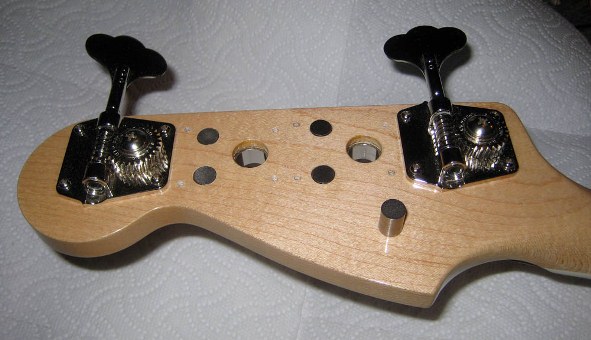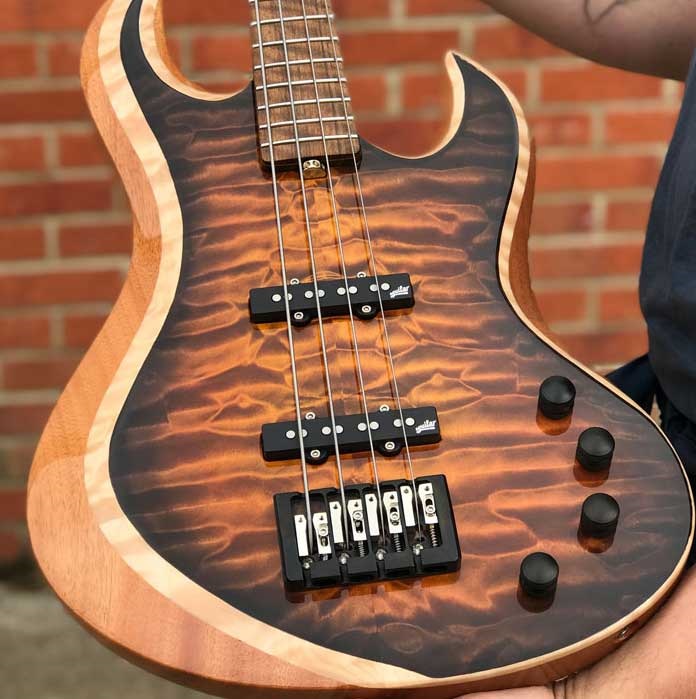A horrid deadspot. It’s a very common problem haunting many Fender basses. Usually on the G-string, somewhere around he C-note. And many have gone to pretty far extremes trying to treat the ailment.
But an ingenious solution from John K of John K Custom Vintage Guitars may just be the simple fix you need.
“Way back in 1979, when I discussed this issue with Leo Fender, he pulled out a small C clamp, clamped it on the headstock and said, ‘Play it now.'” John says in a TalkBass forum thread.
“Sure enough, it was gone. And although it probably moved to a lower note, I sure as heck couldn’t find it.”
That got John thinking last month, so he set to work experimenting with different size and weight “C” clamps on his bass.
But having a clamp attached to your bass all the time is hardly a clean solution. So after discovery that the smallest 3 oz. C clamp got the job done, John was off to the local hobby shop for some 3/8″ tungsten cylinder weights.
Usually used for adding heft to young boys pinewood derby cars, Jon had something different in mind for the weights.
“Figuring that it was going to take at least 2 oz of weight to solve it, I removed two machine heads and bored two 3/8″ holes under each of them to inlay the 1/2oz tungsten cylinders.”
Testing along the way, he arrived at a solution of using four weights, hidden behind the machine heads.
“I tested it again and the dead spot was not only gone, but it didn’t seem to affect any of the other notes. I bored the holes so the weights would sit flush and epoxied them in.”
“The 2oz of added weight has not upset the balance of the bass at all. It’s still very lightweight at 7lbs 11oz, and all of the notes sustain and ring out beautifully (running a set of TI Jazz flats on it)”
“I couldn’t be happier with the bass now.”
It seems like a rather mindbogglingly genius solution to a problem that effects so many basses. Has anyone else given this a go? Doesn’t anyone else have any similar solutions to a problem that might be wrecking havoc on basses? Let us know in the comments.




My P Bass does not have that problem that i’m aware of but my Music Man has an issue that i’m told is typical of the brand. That is that the D and G strings are not as loud or punchy as the lower E and A strings. When playing with a band the D and G just dont cut through the sound. Any ideas?
Regards, Colin Meagher.
Hav u tried raising your pickups under the d/g strings and lowering the same pickups under your a/e strings till you get a more ballanced sound?
If you have an earlier model Stingray with lower pole pieces on the E & G strings, you can try carefully pushing the G poles from behind to raise them. This combined with care full height adjustment solved this issue on my ’93 Stingray.
I eliminated this minor problem with much less work. Hipshot tuners. They have a full diameter peg that does the same thing but without taking a chance on destroying the neck. One small mistake and your typical do-it yourself guitar tech is in for a huge repair/ replacement. I wouldn’t recommend this surgery.
What kind of Hipshot tuners ? 3/8″ or 1/2″ ? Will the modern look work ? I am not fond of the classic clover leaf style, but the modern Gotoh style. Thanks !
I have a ’64 Precision which I strung with Rotosound wirewound 45-105 for years and just accepted the dead spots. I changed to Elites staineless 45-105 and the dead spots were gone.
Google Fender Fat Finger–same effect, no modifications
I’ve seen John K’s mod in an online bass forum last year, it is a pretty good idea and it doesn’t mess up your headstock looks, like a Fat Finger does. I have a Fat Finger and it does work, but it stays in the case because it makes my bass look like it is recovering from a broken bone…
I had the same problem with my jazz bass for a long time, then I switched my saddles to graph-tech and “low end” behold, all my notes were ringing nice and clear!
Hi Brandon, in my experience, changing the saddles for a different type may have improved the tone to your liking but they will have eefect on the resonant frequency of the neck which is what is responsible for deadspots. best, john
sorry for the typo, i meant to say that they will have NO effect on the resonant frequency of the neck or the dead spots.
I play a Fender J-Bass fretless and use flatwound strings and I do not have this issue.
I have designed new machine heads to help contra despots, check them on your tube. http://www.youtube.com/watch?v=HIdpkPsCQTQ
about 25 years ago, here in europe, they solved us by placing a copper plate against the back of the haedstock,cutted nicely in the shape of the haedstock. it killed the dead spots and gave some more sustain to bass. it did affect the balance, though
A long time ago, 25 years or so, I’heard about placing a small copper ball in the neck just behind the dead spots. or placing a copper plate to the back of the headstock, nicely cut in the same form. the last one throws off the balance of the bass.
How about clip-on tuners? …any benefit? …just wondering.
yes clip on tuners have great benefit on it !
never noticed in in mine
I was thinking of something like this to try and gain more sustain… Does anyone think this would work? I do not want a weight just hanging around per say, I just want a hidden way of adding sustain.
It was very bad on my Thunderbird bass (at B to Db on the G string). I used stick-on wheel balancing weights for aluminum/mag wheels. Not as elegant a solution, but equally effective.
This is an amazing post especially when I am struggling with dead E- string on Rickenbacker 4003 bass guitars. Has anyone used this technique to solve that problem?
Usually when I’ve had a dead E string on a Ric it was due to a bad string, particularly if it was a RotoSound string. I’ve had bad E strings right out of brand new packs. If changing the string doesn’t fix the problem it could be either the nut or bridge saddle improperly filed causing a soft contact point under the string.
I use a GrooveTubes Fatfinger on the headstock…awesome result.
I did the whole “copper plate in the shape of the headstock”-thing on an early bass of mine (a Fernandes 4-string like Rocco Prestia used to play), and it did nothing to fix dead spots or sustain issues. The method in the article sounds very worthwhile (like to hear a before and after).
I have a bit of an unusual dead spot: I have a ’92 Jazz Bass Plus and the dead spot is at the 7th fret, D string (A note). Interesting, it is not even slightly present on any other A note, fretted or harmonic. I am wondering if anyone has had a similar issue and if this method worked?
I’ve got the same problem too exactly the same spot.i’ve tried replacing the bridge saddle,machine head tuner but to no good.my bass have two truss rods,somewhere i’ve read that it has something to do with the deadspot,don’t really know.i tried detuning it to a whole step lower and the dead spot moved to note B on the D string.still looking for solution…
My dead spots are similar but more weird. 7th fret, G-string. When I mute the D-string with my hand, the fundamental tone decays rapidly and the sound is thin and has those strange harmonics. When I let the D-string vibrate with the fretted 7th fret G-string, the note sounds fine. I loosened the d-string to complete slackness and got the same strange deadness. Why does the free D-string help keep the fundamental tone of 7th fret G-string ring true?
I have a peavey grind six string all the g and g# notes on every string does not sustain except for low g on e.string ang b.string. Why was that?
I too have problems with the A on my G-string! Have any of you solved the issue? When I put on a C clamp on the headstock, the dead spot moved to a D on the G string.
I’m still trying to figure out what to do with it. Maybe we can use eachothers experience in order to find a solution.
My deadspot was present after ny bass was in a fire accident. I’m thinking that maybe the heat had burned away the moist and other fluids in the wood. I’ve read somewhere that leaving the bass in the bathroom for a couple of days, for moisterizing I presume, can have an effect. I’m going to try that soon.
Too bad Fender can’t come up with a solution to which they created!
I OWN A FENDER BLACK TOP P BASS THE E STRING SOUNDS DEAD SO FRUSTRATED I ENDED UP BUYING A REPLACEMENT NECK
can you tell you have a dead spot on fender bass without an amp?
Interesting reading. I have a dead spot at C on the G string on my ’51 Precision Squier. It bugs me knowing it’s there but really doesn’t affect the usability. Who lets notes ring for seconds in a song? Yeah sometimes but there’s always a different position which has better sustain. I would like to fix it though. I like the bass otherwise.
I think I know the answer, but I’m going to do some experimentation, and provide a root-cause analysis, and provide some easy solutions.
I ended up here after discovering a newer bass of mine has a couple of totally dead spots. Never knew it for months but was tracking a new song the other night that has long, high single notes and one of them went dead so quickly i would have sworn something had fallen across the strings. It was so dramatic i wondered if it was just getting washed out in the headphone mix but I could feel it in the vibration of the bass and could actually SEE it in the Studio One track i was laying down.
I isolated it to a couple of frets on the D string and ended up Googling my way to a talkbass forum that said it’s the manifestation of the string and the bass resonating at the same frequency and the two just cancel each other out. Basically, the fix was, “add some weight to the headstock”. I was skeptical but clipped on my little Snark tuner and, kaboom. Gone. It was shocking. My bass is a 35″ scale boutique 5-string in the style of a Fender J bass. It’s about 8 pounds all-in so im wondering if this is a phenomenon that is more common in lighter basses than heavy ones. I have about a dozen basses at the moment and haven’t experienced this on any of them, but the Snark was like a silver bullet against that issue.